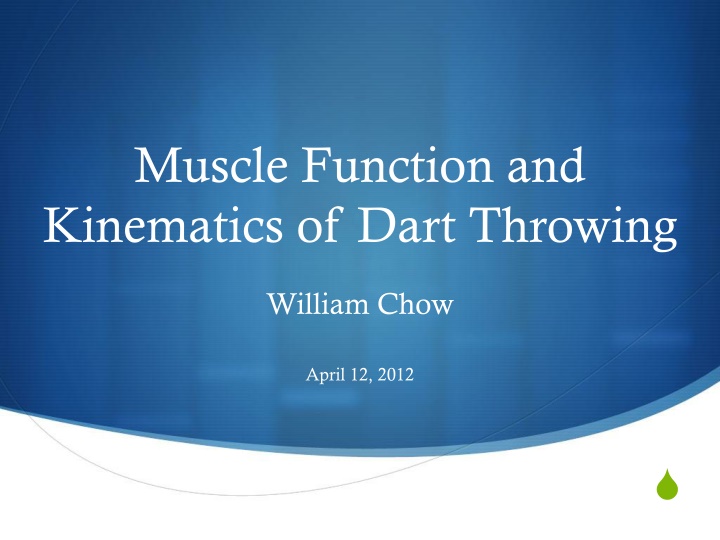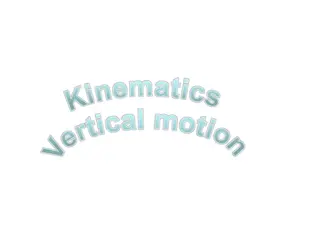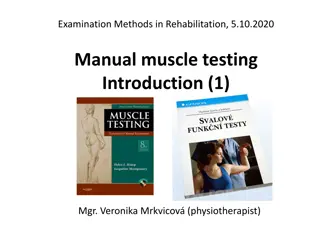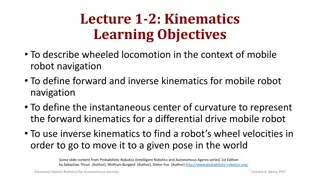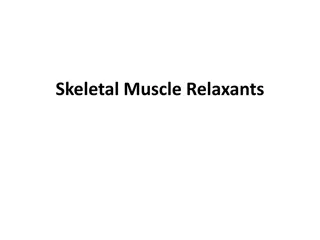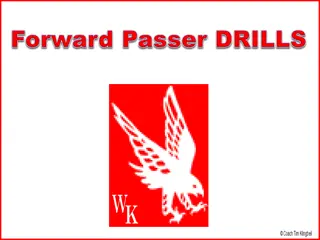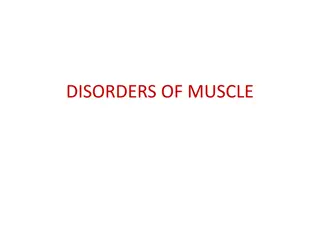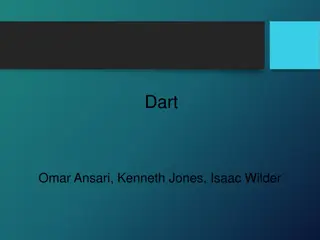Muscle Function and Kinematics of Dart Throwing Analysis
Explore the biomechanics of dart throwing, including muscle function, stretch-shortening cycle, preparation phase, action phase, important muscles involved, displacement vs. time, velocity vs. time, acceleration, and calculations at release point.
Download Presentation

Please find below an Image/Link to download the presentation.
The content on the website is provided AS IS for your information and personal use only. It may not be sold, licensed, or shared on other websites without obtaining consent from the author.If you encounter any issues during the download, it is possible that the publisher has removed the file from their server.
You are allowed to download the files provided on this website for personal or commercial use, subject to the condition that they are used lawfully. All files are the property of their respective owners.
The content on the website is provided AS IS for your information and personal use only. It may not be sold, licensed, or shared on other websites without obtaining consent from the author.
E N D
Presentation Transcript
Muscle Function and Kinematics of Dart Throwing William Chow April 12, 2012
Introduction Darts is an accuracy game Speed-accuracy trade-off Many versions of darts American darts Archery darts Cricket Dart golf Round the clock Fives Halve it Killer Shanghai
Stretch shortening cycle Active stretching of a muscle followed by an immediate shortening of the same muscle
Preparation phase Increases the acceleration path of the object Increases length of muscles responsible for the action
Action phase Range of motion principle Elbow extension and wrist radial/ulnar deviation with slight shoulder flexion
Displacement vs Time Total time = 0.42 seconds Distance traveled (horizontally) = 2.528m Initial height = 1.579m Max height = 1.941m Release point = 1.823m Final height = 1.854m
Calculations at release Max velocity = 8.444 m/s Mass of dart = 0.016 kg Force: F = ma = (0.016 kg)(70.89 m/s2) = 1.134 N Momentum: P = mv = (0.016 kg)(8.444 m/s) = 0.135 N s Impulse: I = m v = (0.016 kg)(8.444 m/s) = 0.135 N s
Calculations at release Kinetic energy: KE = mv2 = = 0.570 J Potential energy: U = mgh = = 0.286 J Work Wx = Fdx = maxdx = (0.016 kg) (65.95 m/s2) (0.397 m) = 0.419 J Wy = Fdy = maydy = (0.016 kg) (23.04 m/s2) (0.232 m) = 0.086 J
Calculations at release Max velocity = 8.444 m/s Projection angle: Vx = Vcos = cos-1 (8.286/8.444) = 11.10
Comparison of multiple throws What affects the final position of the dart? Velocity Point of release Release angle
Displacement vs Time Time = 0.46 seconds Initial height = 1.61 m Release point = 1.91 m Max height = 2.12 m Final height = 2.05 m Time = 0.43 seconds Initial height = 1.60 m Release point = 1.82 m Max height = 1.95 m Final height = 1.72 m
Higher dart throw Lower dart throw
Velocity vs Time Max velocity of high dart = 7.928 m/s a = 67.63 m/s2 Max velocity of low dart = 6.977 m/s a = 63.79 m/s2
Projection angle Projection angle: Vx = Vcos = cos-1 (8.286/8.444) Max velocity of high dart = 7.928 m/s = 23.99 Max velocity of low dart = 6.977 m/s = 6.80
Calculations Formula V = Vx2 + Vy2 F = ma P = mv KE = mv2 U = mgh Higher Dart 7.928 m/s 1.08 N 0.127 N s 0.503 J 0.300 Lower dart 6.977 m/s 1.02 N 0.117 N s 0.389 J 0.286 Max Velocity Force Momentum Kinetic Energy Potential Energy
Conclusions Release velocity of higher throws is greater than lower throws Release point of higher throws is greater than lower throws Possibly due to more shoulder flexion Projection angle of higher throws is greater than lower throws Too many variables to determine which has greatest impact Need a way to hold other variables constant during testing
Clinical Significance Ongoing studies researching wrist motion, specifically the dart-throwing motion Explains how functional abilities in the corresponding planes of motion are affected by disease Found in everyday activities Important for rehabilitation Improve range of motion and strength within the plane of motion
References Crisco JJ, Coburn JC, Moore DC, Akelman E, Weiss AP, Wolfe SW. In vivo radiocarpal kinematics and the dart thrower's motion. J Bone Joint Surg Am. 2005 Dec;87(12):2729-40. Darts. Wikipedia. <http://en.wikipedia.org/wiki/Darts> Lenn, Jay D. (2012) Mapping the dart thrower s arc. AAOS Now. January 2011 Issue. Orthogate. <http://www.orthogate.org/patient-education/hand/guyons-canal- syndrome.html> Shoulder articulations. <http://www.exrx.net/Articulations/Shoulder.html>
